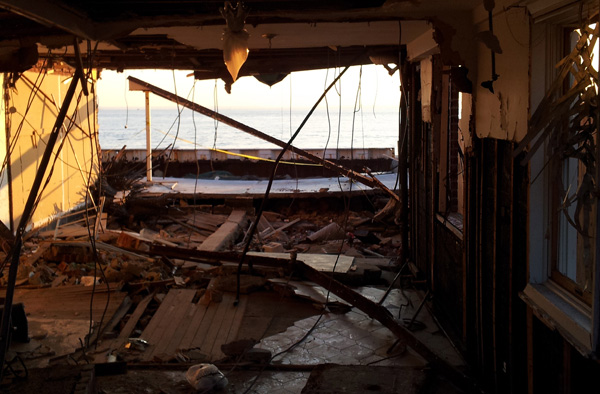
Photo by: Batya Ungar-Sargon
In Sea Gate, the ocean is visible through the ruins of several houses.
At the tip of the Coney Island Peninsula stands a gated community of mostly one and two family homes. The sprawling seaside neighborhood poses a stark contrast to that which lies “outside the gate” as residents refer to the larger Coney Island area, with its high-rises and public housing.
Census data reveal the disparity between Sea Gate and its neighbors. The population of this suburban haven is over 90 percent white, compared to the census tracts just east of it with populations that range from 30 percent to just 8 percent white. The median household income in Sea Gate is $56,000, compared to Coney Island’s overall figure of $30,000. While not everyone who lives in Sea Gate is wealthy, the community is solidly middle class, with a poverty rate around 14 percent; it’s 28 percent in the wider neighborhood. The neighborhood is patrolled by its own police, who stand guard at each of the gates.
Residents on both side of the gate say they were grateful for the Red Cross, who kept them fed in the immediate and not-so-immediate aftermath of Hurricane Sandy.
Last Wednesday, Atlantic Avenue, the southernmost street in Sea Gate, was eerily quiet. The houses directly facing the ocean have been demolished, though their foundations still stand. Through their skeletons the ocean is visible. Many are tagged with yellow signs from the city to indicate that they are uninhabitable.
Noah Silecchia is a 22-year-old who has lived in Sea Gate his entire life. “What you have to understand is that everything flows to Sea Gate,” explains. “Outside the gate, when the sewers went down, they all dried out. In my house, the water was still thigh high for another 24 hours.” He was “out there” when the hurricane hit, and says he “had to literally swim up Mermaid Avenue.” Finally, he and some friends climbed up a fire escape and into a house to wait out the storm.
He recalls the chilling scene that waited for him upon his return. “My whole neighborhood, everything I’ve ever known—gone,” he says. “There were a lot of people standing, thinking, ‘What am I going to do? How do I get past this?'”
Noah is helping restore one of the shoreline homes that Sandy demolished which belongs to friends. The basement was washed away, though the foundation is visible through the wreckage.
“There was looting, too,” he reports about the immediate aftermath of the storm. “I saw 20 five people in front of a dollar store trying to break in. Keyfood got robbed. On Mermaid and West 15th I saw a lady get robbed while she was being evaluated by FEMA! But what are you going to do? The 60th Precinct was under water.” He points to the home next to the one he is renovating. “She got robbed. She didn’t board up and she got robbed.”
According to the New York Police Department, in the past month the 60th precinct has seen a 164 percent rise in burglaries and a 10 percent increase in grand larceny compared to the same period last year. Car thefts are also way up. But violent crime is down.







